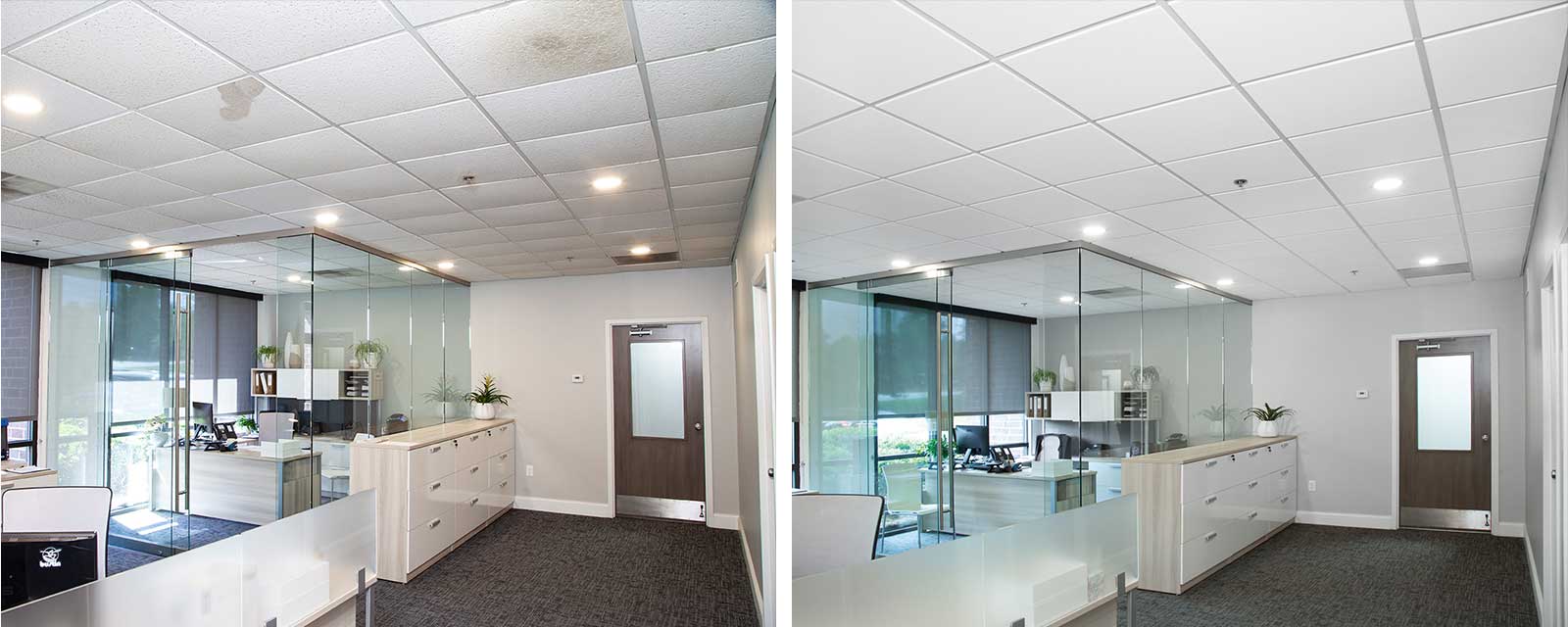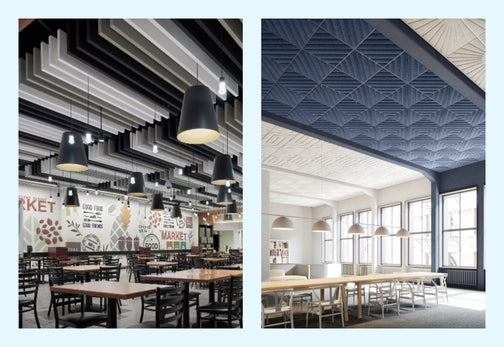Replacing drop ceiling tiles the right way

Whether you’re refreshing all your ceiling tiles or replacing a few damaged tiles, here’s the when, why, and how to do it correctly.
What is a drop ceiling?
A drop ceiling consists of a suspended metal grid that hangs below the structural ceiling. Ceiling tiles or panels are then placed in the grid to complete the finished look. Learn more about the components of a drop ceiling below.

A. Main Beams carry the load of the grid system, typically 12’ or 6’.
B. Cross Tees are the supporting grid pieces that attach perpendicular to the main beams, helping create the 24” x 24” or 24” x 48” openings needed for your tiles.
C. Wall Moldings are used as finishing trim to hang against the walls in the space.
D. Ceiling Tiles are the tiles used to make up the drop ceiling.
E. Hanger Wires attach to the ceiling joists and are how the main beams and cross tees hang.
F. Plenum is the area or space in between the drop ceiling and the structure above, typically floor joists or an old ceiling.
The benefits of installing a drop ceiling include hiding ductwork and wiring while allowing targeted maintenance of HVAC and electrical systems. Drop ceilings also enhance the appearance of a space while absorbing or blocking sounds or a combination of both. Various styles and performance features are available to meet the needs of any space.
When to replace ceiling tiles?
Issues above: Any business or homeowner knows that things break. Leaks and electrical problems can impact your ceiling tiles and require some of them to be replaced. Make repairs, checking for mold and mildew if you have a leak. If any moisture has permeated the ceiling and mold is present, you’ll want to have the mold remediated professionally.
Impacts below: Certain ceiling tiles can't withstand physical impact from objects below. Tiles can break, show scratches or dents, or may accumulate dirt and stains. Replacement tiles are the perfect solution if any of these things happen in your space.
Find your replacement ceiling tiles
Kanopi has the tools and resources to help you get started.
Full ceiling update: Older ceiling tiles can easily be replaced with fresh, new ones. If your grid holds 24" x 48" tiles, try a "scored" product that's designed to look like 24" x 24" panels. With this style, you won't need to purchase additional cross tees. However, you can update your look and explore more 24” x 24” style options when you add 2' cross tees to your existing grid. Whatever size and style you choose, consider upgrading to tiles with performance attributes like sag, mold and mildew resistance, and sound absorption or blocking. You can choose from a variety of designs, sizes, and materials to level up your space.
Ceiling tile replacement: If you are doing a swap of one or two ceiling tiles, matching the rest of the ceiling tiles is extremely important. This can be done in three easy steps:

How to pick the right ceiling: If you are replacing the whole ceiling, let us help with picking the right ceiling tiles for your space.
1. Determine the installation Method.
2. Choose the look you want.
3. Consider the different performance features.
How to replace drop ceiling tiles
Once you find the right replacement tiles, then you are ready to replace!
1. Identify the ceiling tiles you want to replace

2. To remove tiles from the grid, push up gently and remove
3. Fix any issues that caused the damage
4. Insert your new ceiling tiles
Here are a few resources to help you with planning, cutting, and replacing your ceiling tiles.
Replace your ceiling tiles with Kanopi
Upgrade your ceiling with a few new tiles or complete a full ceiling refresh with ceiling tiles from Kanopi by Armstrong World Industries. We’re here to help!
Contact the experts at Kanopi today to choose the best ceiling for your project.
Ceiling replacement FAQ's
What are the signs that my ceiling tiles need replacement?
If your ceiling tiles are 10 years or older, you’ll want to start thinking about swapping ceiling tiles. Any suspended grid system over 30 years old should be replaced entirely to meet safety and compliance standards. Other signs include stains, discoloration, odors, broken or missing tiles, and any damage from gaining access over the years.
What materials are commonly used in replacement ceiling tiles?
Mineral fiber ceiling tiles contain at least 24% recycled materials and some as much as 95%. They also contain renewable and natural materials including starch, perlite, and clay.
Are replacement ceiling tiles easy to install?
Yes, replacing ceiling tiles is considered a DIY job. You’ll want to make sure you have a ladder, safety glasses, and any tools you’ll need for cutting borders or spaces for lights and vents.
Can replacement ceiling tiles help with energy efficiency?
Yes, Kanopi by Armstrong carries Armstrong’s revolutionary TEMPLOK ceiling tiles. Learn more about Energy Saving Ceilings here.



 Thanks for subscribing!
Thanks for subscribing!

